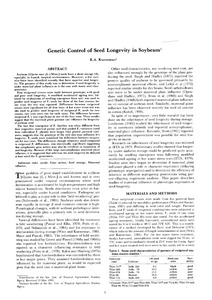| dc.contributor.author | Kueneman, E.A. |
| dc.date.accessioned | 2019-12-04T11:24:00Z |
| dc.date.available | 2019-12-04T11:24:00Z |
| dc.date.issued | 1983 |
| dc.identifier.citation | Kueneman, E. A. (1983). Genetic control of seed Longevity in soybeans 1. Crop Science, 23(1), 5-8. |
| dc.identifier.issn | 0011-183X |
| dc.identifier.uri | https://hdl.handle.net/20.500.12478/4240 |
| dc.description.abstract | Soybean [Glycine max (L.) Merr.] seeds have a short storage life, especially in humid, tropical environments. However, a few varieties have been identified recently that have superior seed longevity. The purpose of this study was to determine if seed longevity is under maternal plant influence as is the case with many seed characteristics.
Four reciprocal crosses were made between genotypes with good and poor seed longevity. A modified accelerated ageing test, followed by evaluations of seedling emergence from soil, was used to predict seed longevity of F1 seeds for three of the four crosses; for one cross the test was repeated. Differences between reciprocal crosses were significant for all four tests. A hot water stress test was also used to predict seed longevity of reciprocal F1 seeds for two crosses; two tests were run for each cross. The difference between reciprocal F1's was significant in one of the four tests. These results suggest that the maternal plant genome can influence the longevity of soybean seed.
The fact that emergence of F1 families was often different from their respective maternal parent and that pooled F2 variances (seed from individual F1 plants) were larger than pooled parental variances, suggests that the genotype of the seed also may influence it's longevity. F2 seeds were examined for differences between reciprocals for one cross. The difference, though relatively small compared to reciprocal F1 differences, was statistically significant suggesting that cytoplasmic gene action may also be involved in expression of seed longevity. Because of the large noncytoplasmimc aternal plant influence, it is suggested that selection for seed longevity be delayed at least until the F3 generation. |
| dc.language.iso | en |
| dc.subject | Gene Activators |
| dc.subject | Seed Storage |
| dc.subject | Maternal Influence |
| dc.subject | Soybeans |
| dc.title | Genectic control of seed longevity in soybeans |
| dc.type | Journal Article |
| dc.type | Journal Article |
| dc.description.version | Peer Review |
| cg.contributor.affiliation | International Institute of Tropical Agriculture |
| cg.coverage.region | Africa |
| cg.coverage.region | West Africa |
| cg.coverage.region | East Africa |
| cg.coverage.country | Nigeria |
| cg.coverage.country | Tanzania |
| cg.isijournal | ISI Journal |
| cg.authorship.types | CGIAR single centre |
| cg.iitasubject | Crop Systems |
| cg.iitasubject | Soybean |
| cg.accessibilitystatus | Limited Access |
| local.dspaceid | 99806 |

